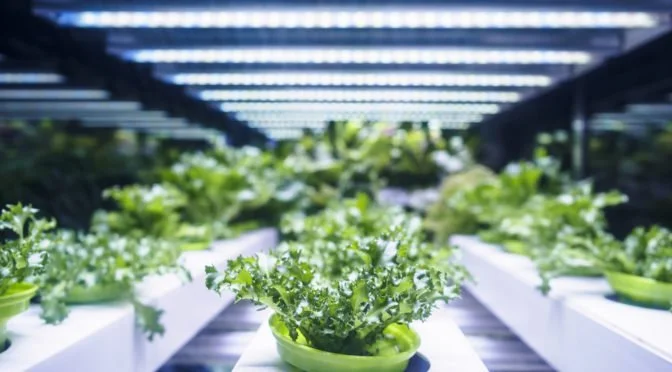Lessons Learned: Weighing The Costs And Benefits of Vertical Farms
April 15, 2022 Peter Tasgal
Peter Tasgal is a strategic consultant to the food and agriculture industries and co-founder of Farmbook Project, based in Boston, US.
The views expressed in this guest article are the author’s own and do not necessarily represent those of AFN.
The recent publicity of French vertical farming company Agricool’s placement into receivership has shed light on challenges in the vertical farm industry.
Outputs from vertical farms can be highly precise because the inputs and growing environment are highly precise. But achieving a high level of precision can be more costly than an automated greenhouses, and much more costly than growing outdoors. That is beacuse of the type of farming structure vertical farming required and the specific set of required ingredients – known collectively as the “recipe”: seed, light, nutrients, temperature, humidity, carbon dioxide, labor and time.
As such, it is important to weigh the benefits compared to the costs of such precision when deciding to pursue vertical farming.
Cost considerations
Vertical farms are complex systems which require lighting, fertigation, heating, ventilation, air conditioning, mobility, software, and artificial intelligence. All of this has to be well-integrated to achieve the desired results.
Combined, those factors can drive the capital expenditures of a vertical farm up to 4x (or more) of the cost of a high-tech greenhouse, according to Daniele Modesto, CEO of ZERO Farms in Italy. Modesto noted that while automated vertical farms require less labor than traditional or greenhouse farms, they require more highly-skilled (and highly-paid) workers: engineers, software developers, and agronomists, for example. Pricing of products from a vertical farm, he said, needs to be 2x that of organic products in Italy.
The figures Modesto outlined seem to play out similarly in the US. According to a CNBC article last month, a 180,000-square-foot vertical farm built by seasoned operator Fifth Season in Columbus, Ohio will require a $70 million expenditure. This equates to $17 million per acre.
Vertical farms grow in layers, therefore the expenditure per square foot of growing space is lower than a high-tech greenhouse but still significantly more expensive.
Market considerations
There are several attributes of products that are well suited for vertical farms, namely: products which require a high level of precision and products with limited alternatives or substitutions.
There are also several attributes of customers well suited for vertically-farmed products: people in locations with significant land and water premiums; and demographics with means and willingness to pay for premium-priced products.
Products for which the customer is more focused on precise attributes, as compared to price, are ideal candidates for vertical farming, such as: pharmaceuticals, highly-specialized fruits and vegetables (ex. premium strawberries), premium and specialized leafy greens and herbs, and cannabis products.
In the cannabis industry, for example, marijuana flowers that pass a microbial test command a significant price premium because the flower does not need to be manufactured into an alternative form. If indoor growing conditions can impact the percentage of flowers that pass the test, cannabis could be a strong candidate for indoor vertical farming.
What is the future of container farming?
Growing in retrofit shipping containers has received significant buzz over the past five to 10 years as produce is grown hyper-locally on a small footprint. But how viable is this form of growing in the long term?
Return on investment
The vertical farm industry will continue to grow if investors are able to achieve an appropriate risk-adjusted returns on their investment. Investment considerations should include each of the following:
Total addressable market (TAM)
Pricing analysis
Profit margin analysis
Farm size relative to demand expectations
Size of investment
To date, inappropriate sizing of TAM has caused many of the underperforming investments in the space. Fresh herbs, for example, are often grown in vertical farms. They are attractive for indoor farming because a high level of precision is required for specific flavor profiles and because herbs have limited substitutes. But consumers often do not buy large quantities of herbs at a time.
When Agricool expanded from growing and selling strawberries (c. 2015) in French supermarkets to herbs and greens, it priced 11-gram packets of herbs at €1.99. To sell $1 million of fresh herbs, Agricool’s retailers would need to sell 448,000 individual packages of fresh herbs—or nearly 900,000 packages if Agricool gives its retailers a 50% cut.
Because vertical farms are capital intensive, farms’ output needs to deliver significant profit margins and a high level of cash flow generation. In cases where the TAM is overstated, the time necessary to achieve an appropriate return lengthens and returns to investors decrease.
The technology, of course, has a place in the agriculture supply chain along with greenhouses and conventional outdoor farms. But investors and operators must carefully analyze the TAM for each product grown against vertical farms’ building and operating costs relative to other growing methods.
controlled environment agriculture, indoor ag, indoor agriculture, indoor farming, vertical farm, vertical farming


